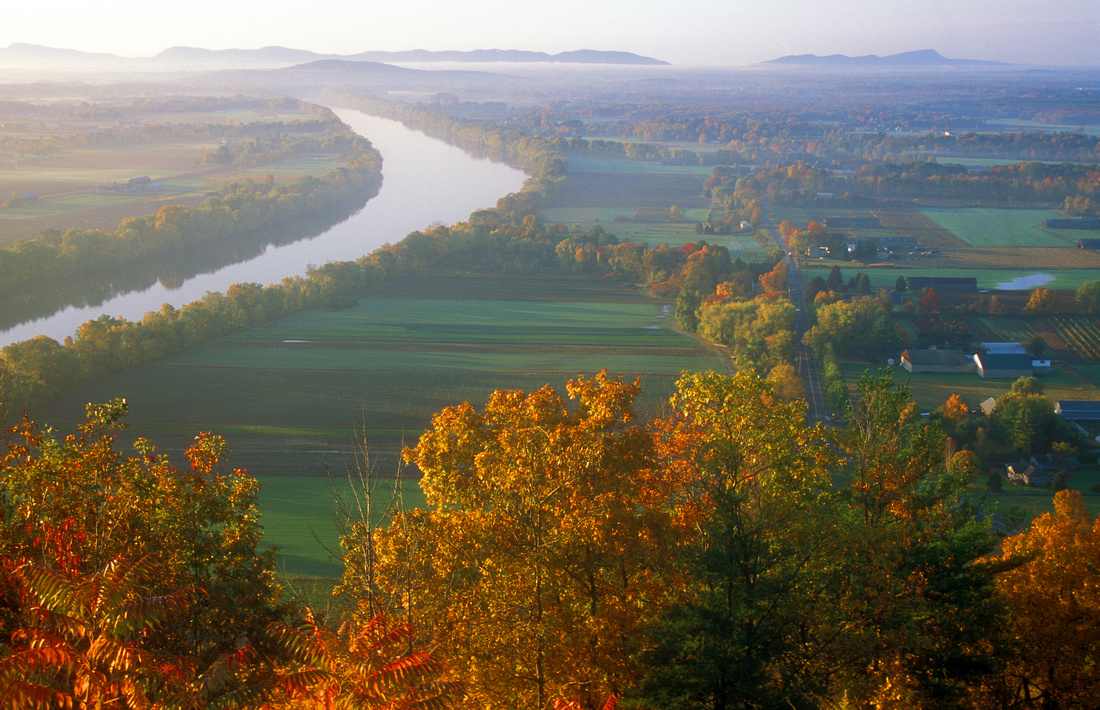Fall Foliage Viewing in Western Massachusetts from Quabbin to the Berkshires
With leaves having only recently emerged on the trees, it may seem a bit early to be thinking of fall foliage, and many of us are certainly in no hurry to think beyond the warm weather. However, since many people make travel plans in advance and I often get asked about viewing routes and trails, here are some thoughts and recommendations.
For a (mercifully) quick geography primer, the area west of the Connecticut Valley, especially Berkshire County, is comprised of the Appalachian Mountains and their foothills. The higher summits, which are basically southerly extensions of the Green and Taconic Mountains of Vermont, range in elevation from 2000 to 3500 feet, capped by Mount Greylock in the state's northwest corner. The Connecticut River Valley has a much lower elevation, but is home to a number of low mountains, hills, and ridges which were formed by ancient volcanoes. Although these peaks are low in statue - just a few hundred feet in some instances - don't let the numbers fool you, as they have outstanding panoramic views. To the east, the center of the state has many rolling hills and wetlands, with a few isolated higher mountains of 1500-2000 feet. The view below is from Mount Sugarloaf in South Deerfield, at an elevation of only 650 feet!


How does this relate to foliage viewing? There are subtle differences in the forest types - the colorful northern hardwoods such as maples, birches, and beeches are common at the higher elevations, which oaks are predominant lower. The peak foliage viewing correspondingly occurs earlier at the higher elevations to the west, and later in the valleys. If you miss great color in the Berkshires, head to the valleys, and if it's mostly green in the valleys, head for the mountains.
Defining the 'peak' can be a bit tricky, especially with some of the unusual autumns we've been having recently -- 2011 was a prime example. Columbus Day weekend is traditionally cited as an optimal time, but you will often find the best color in the Connecticut, Millers, and Quabbin Valleys later in October, and some pockets of oak and beech foliage may be visible into November. It's best to follow updates and the weather during a given year - pay attention to those cold and frosty nights, as they trigger leaf color changes.
For photographers, the region has a nice diversity of subject matter. There are mountaintop and hill views, rivers, wetlands, small towns with historic commons and churches, a handful of historic covered bridges, and scenic valley farms with pumpkin patches and roadside stands. There are a full range of driving, hiking, and other recreational options, and many nature preserves and state forests.
In the next installment I'll share some suggested routes and destinations.
Comments
<a title="mobile gadgets in pakistan" href="https://bluegadgets.pk/">mobile gadgets in pakistan</a>
<a title="iphone cases" https://bluegadgets.pk/product-category/cases/iphone-15-pro-max/">iphone cases</a>
<a title="iphone cases pakistan" href="https://bluegadgets.pk/product-category/cases/">iphone cases pakistan</a>
<a title="mobile shop" href="https://bluegadgets.pk/product-category/accessories/">mobile shop</a>
<a title="the mobile shop" href="https://bluegadgets.pk/">the mobile shop</a>
<a title="mobile shop near me"https://bluegadgets.pk/product-category/straps/">mobile shop near me</a>
<a title="phone gadgets" href="https://bluegadgets.pk/">phone gadgets</a>
<a title="mobile phone gadgets accessories"https://bluegadgets.pk/product-category/accessories/">mobile phone gadgets accessories</a>
<a title="chargers" href="https://bluegadgets.pk/product-category/accessories/charger/">chargers</a>
[url=https://bluegadgets.pk/product-category/cases/]mobile accessories shop[/url]
[url=https://bluegadgets.pk/product-category/accessories/]online mobile accessories in pakistan[/url]
[url=https://bluegadgets.pk/product-category/straps/]best mobile accessories brand in pakistan[/url]
[url=https://bluegadgets.pk/product-category/gadgets/headphone/]mobile accessories images[/url]
[url=https://bluegadgets.pk/product-category/gadgets/smart-watches/]mobile gadgets[/url]
Econix digital is a full-service Digital Marketing Agency that specializes in web design, eCommerce (Shopify), social media marketing, SEO, conversion rate optimization, PPC/SEM, Sales Funnels, and UI/UX services. Our team of professionals provides a customized approach to our client's needs by blending the latest digital marketing strategies
Econix digital is a full-service Digital Marketing Agency that specializes in web design, eCommerce (Shopify), social media marketing, SEO, conversion rate optimization, PPC/SEM, Sales Funnels, and UI/UX services. Our team of professionals provides a customized approach to our client's needs by blending the latest digital marketing strategies"